When it comes to saltwater aquariums, Yellow Tangs are by far one of the most popular fish to grace the hobby. They are brightly colored, beautiful, and extremely active fish. It is clear to see why they are so popular - not only are they attractive fish but they have a peaceful and somewhat shy personality too.
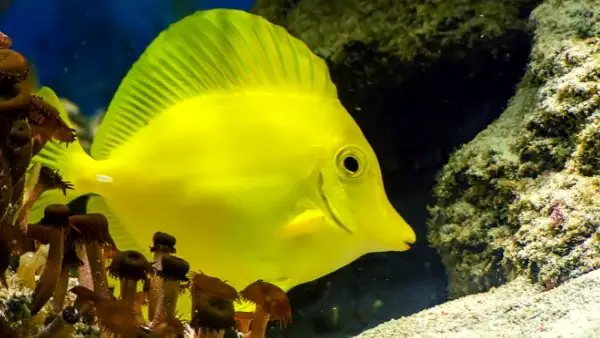
Yellow tangs are certainly a great fish to have in your saltwater aquarium, however, they aren't well-suited to all aquarium setups. Due to their active nature, they require large and open spaces to swim freely and happily. So, let's find out how to properly take care and setup a the famous yellow tang surgeonfish.
Yellow Tang General Information and Requirement Overview
Here is a quick overview of the topics that will be covered in this complete care guide on the majestic yellow tang:
- Other names: Yellow Tang, Yellow Hawaiian Tang, and Yellow Surgeonfish.
- Scientific name: Zebrasoma Flavescens.
- Temperature: 72 to 82°F (22 - 28°C).
- Diet: Typically, yellow tangs are omnivores and will require a balanced diet of fish and meats, with vegetables and plant matter.
- pH level: 8.1 to 8.4.
- Maximum size: 8 inches (20 cm) in length.
- Minimum tank size: 55 Gallon (208 liters).
- Temperament: Peaceful and active.
- Coloration and pattern: Bright yellow in color with no real pattern.
- Care level: Very easy to care for, suitable for beginners.
- Reef compatibility: Reef safe.
- Lifespan: Between 5 to 20 years.
Are yellow tangs good for beginners? Yes, yellow tangs are certainly compatible with beginner hobbyists due to their peaceful nature, hardiness, and general low maintenance.
Behavior and Personality
These fish have tremendous personalities and are incredibly active swimmers all through the day. They are calm and peaceful but somewhat timid, which is good but not if there are overly aggressive fish in your tank with them. It will take them a bit of time to settle in and feel comfortable, which is when their budding personalities begin to shine through.
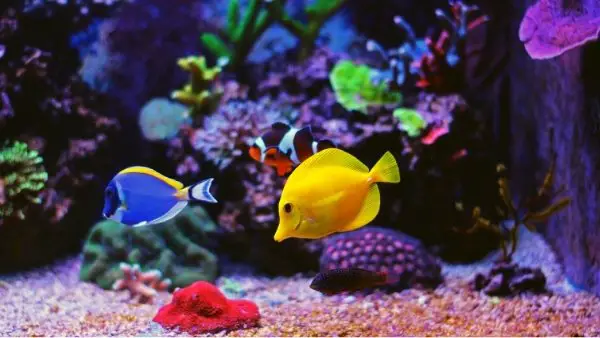
They are not known for being aggressive towards other fish species, but they can be towards their own. Their bodies are oval-shaped with a large dorsal fin, which they will use to move rocks around. Although very peaceful fish, they do have a defense mechanism against aggressors, a sharp white spear that they will use to defend their territory or establish a new territory.
Natural Habitat
Yellow tangs originate from the tropical pacific waters of Hawaii, the Great Barrier Reef in Australia, Indonesia, and the Pacific Ocean. Typically, when in the wild you will see these tangs darting around reefs, grazing off the algae on rocks and coral all day. They feed primarily off algae, which is why they are fantastic at keeping your aquarium clean and top algae eaters.
Yellow Tang Tank Setup
Tank setup is probably the most important aspect of fishkeeping, regardless of whether you own a freshwater or saltwater aquarium. By not following a correct tank setup you risk your fish becoming ill and dying within minutes.
Ideal Water Temperature
Yellow tangs are incredibly hardy and will thrive in tanks that are between 72 to 82°F (22-28°C), have a pH level of 8.1 to 8.4, and a specific gravity of 1.020 to 1.026. They will need a good amount of water flow and can be added to any reef tank as long as it is big enough.
What Size Tank Does a Yellow Tang Need?
If you do not set up your fish tank correctly, you cannot expect the inhabitants to live healthily and happily. 100 Gallons (454 Liters) is the minimum tank size for the Yellow tang. With these tangs, the bigger the tank, the better. They are active swimmers and need large spaces to do so, they also do enjoy residing underneath cover at nighttime to sleep comfortably and safely.
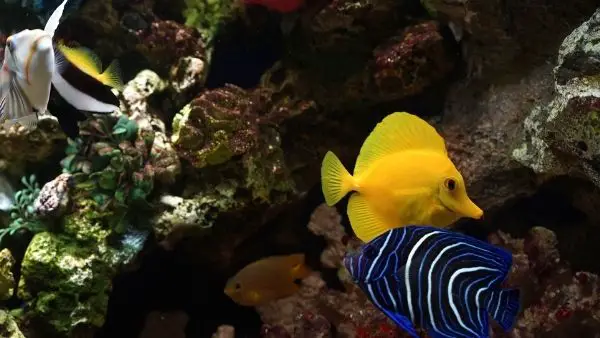
Yellow Tang Compatibility
Yellow tangs are model citizens, getting along well with other fish species, which makes them a great addition to most tanks. You shouldn't really have two of the same tang species residing in the same tank. However, they are schooling fish, so if you really do want to keep more than 1 you should add 3 to spread out the aggressiveness and hopefully level it out due to having one male per two females- keep a close eye on them to see if they are playing nicely with one another.
Some good yellow tang tank mates include:
1. Vlamingi Tang
2. Clownfish
3. Sailfin Tang
4. Blue Tang
5. Copperband Butterfly
6. Cleaner Wrasse
7. Royal Gramma
These tangs will thrive living with pretty much any other fish species, corals and invertebrates make for excellent tank mates too. To maintain the peace and keep Yellow tangs happy, you will want to keep them away from large and aggressive fish such as Lionfish, Groupers, and Sharks.
Yellow Tang Disease
Much the same for all fish, Yellow tangs are susceptible to picking up many different diseases. When you purchase your Yellow tang, you should look for a plump, healthy, bright, and well-nourished tang.
The fins and body should be in good condition, and their breathing should be visibly steady whilst they are swimming. Ich and marine velvet are some classic diseases these tangs have been known to pick up, so look out for them. Below is an image of a yellow tang that has unfortunately picked up marine ich, which has began taking over the appearance of the fish, displaying white markings across the face and body.
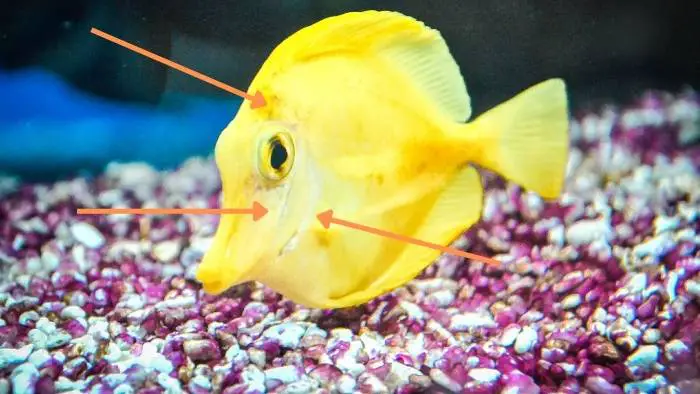
It is always good to quarantine any saltwater fish, or any aquarium fish for that matter before you add them to your tank. This will help reduce the chance of infecting your healthy fish community.
Breeding
Yellow tangs do not breed in home aquariums. However, it is in the works. The Oceanic Institute at Hawaii Pacific University has made a recent breakthrough, they have successfully bred and raised the first aqua-cultured Yellow tangs! Soon enough you will be able to purchase aqua-cultured Yellow tangs at your local fish store.
The great thing with captive-bred tangs is that they are far less likely to catch, carry, and pass on diseases, and they are typically a lot smaller than when wild-caught, which means you can get away with using a slightly smaller aquarium.
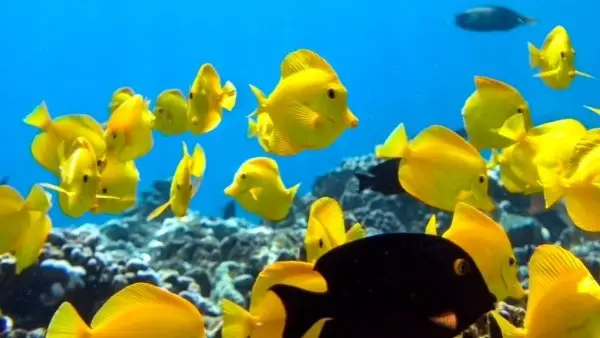
There are not too many differences between males and females, both tangs look very similar. The females tend to be a little larger, and you might not be able to tell the difference very easily when in your aquarium.
Yellow Tang Food & Diet
Yellow tangs are omnivores, meaning that their diet should be balanced and consist of meat and fish, as well as a healthy amount of vegetables and plant matter. Yellow tangs have also gathered a reputation for being brilliant saltwater algae eaters, keeping your tank clean whilst maintaining a healthy diet.
Yellow Tang Diet
The Yellow Tangs are brilliant at what they do and are certainly one of the best and most effective saltwater algae-eating fish out there. However, they will need more than just algae to live a healthy life.
Feeding your yellow tang a mixture of plant matter, flakes, and pellets, with the addition of meats such as bloodworms and shrimp will ensure that they are receiving the most balanced diet possible.
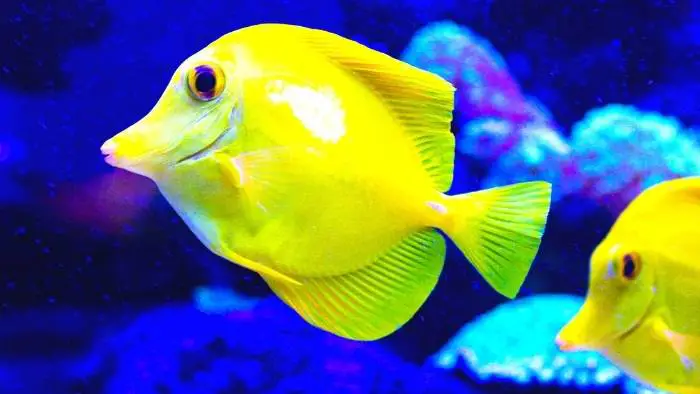
How Often Should You Feed a Yellow Tang?
You should feed your yellow tang at least once a day. Yellow tangs are busy fish but they like to eat slowly, over a period of around 2-4 hours, so, it is recommended to add plenty of food for them to incrementally feed off throughout the day.
Yellow Tang Care Guide - Free Downloadable PDF
Due to it being rather difficult to note everything down from this article when setting up your yellow tang aquarium, and keeping all of their requirements in mind, we have created a useful and colorful PDF for you to use as a reference going forward.
All you need to do is click the button below and you will have a free PDF consisting of all the yellow tang requirements and information you will need to take care of them moving forward.
Closing Thoughts
These fish are one of the most beautiful and peaceful species of reef fish that you could acquire for your saltwater aquarium. Not only do Yellow Tangs play well with other fish but they are easy to care for, and are a fantastic member of the saltwater clean-up crew!

